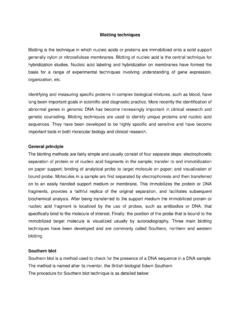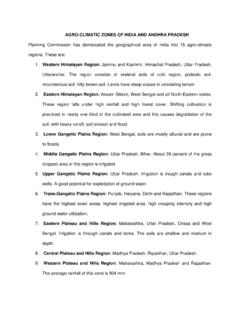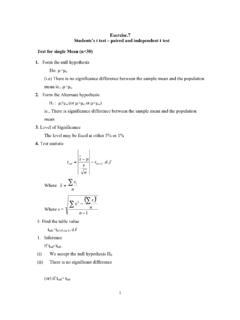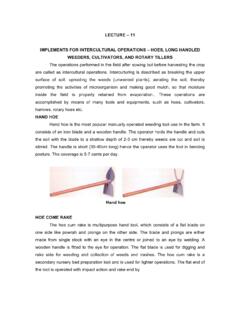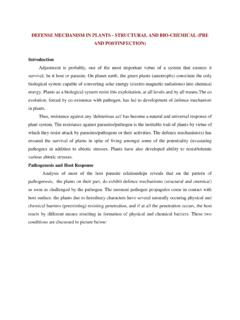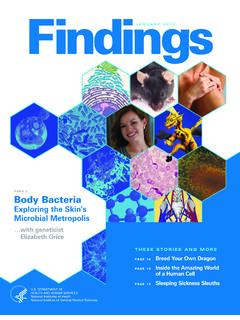Transcription of Study of chromosome structure, morphology, number …
1 Study of chromosome structure , morphology, number and types - Karyotype and Idiogram A chromosome is a structure that occurs within cells and that contains the cell's genetic material. That genetic material, which determines how an organism develops, is a molecule of deoxyribonucleic acid (DNA). A molecule of DNA is a very long, coiled structure that contains many identifiable subunits known as genes. In prokaryotes, or cells without a nucleus, the chromosome is merely a circle of DNA. In eukaryotes, or cells with a distinct nucleus, chromosomes are much more complex in structure .
2 Historical background The terms chromosome and gene were used long before biologists really understood what these structures were. When the Austrian monk and biologist Gregor Mendel (1822 1884) developed the basic ideas of heredity, he assumed that genetic traits were somehow transmitted from parents to offspring in some kind of tiny "package." That package was later given the name " gene ." When the term was first suggested, no one had any idea as to what a gene might look like. The term was used simply to convey the idea that traits are transmitted from one generation to the next in certain discrete units.
3 The term " chromosome " was first suggested in 1888 by the German anatomist Heinrich Wilhelm Gottfried von Waldeyer-Hartz (1836 1921). Waldeyer-Hartz used the term to describe certain structures that form during the process of cell division (reproduction). One of the greatest breakthroughs in the history of biology occurred in 1953 when American biologist James Watson and English chemist Francis Crick discovered the chemical structure of a class of compounds known as deoxyribonucleic acids (DNA). The Watson and Crick discovery made it possible to express biological concepts (such as the gene ) and structures (such as the chromosome ) in concrete chemical terms.
4 According to the classical cytological studies, each chromosome structurally consists of a limiting membrane called pellicle, an amorphous matrix and two very thin, highly coiled filaments called chromonema or chromonemata. Each chromonemata is 800A 0 thick and contains 8-microfibriis, each of which in its turn contains two double helics of DNA. Both chromonematae remain intimately coiled in spiral manner with each other and have a series of microscopically visible bead-like swelling along its length called chromomeres. The early geneticists have attached great significance to the chromomeres and errorneously considered them as hereditary unit, hereditary or Mendelian factors or genes; but modern cytological investigations have confirmed that the chromomeres are not genes but the regions of super-imposed coils.
5 The recent cytological findings have also condemned the view that chromosomes have pellicle, matrix and chromonemata. A. Nucleolus organizer B. chromosome C. Nucleolus The structure of chromosomes and genes A chromosome is an organized structure of DNA and protein that is found in cells. A chromosome is a single piece of coiled DNA containing many genes, regulatory elements and other nucleotide sequences. Chromosomes also contain DNA-bound proteins, which serve to package the DNA and control its functions. The word chromosome comes from the Greek chroma - color and soma - body due to their property of being very strongly stained by particular dyes.
6 Chromosomes vary widely between different organisms. The DNA molecule may be circular or linear, and can be composed of 10,000 to 1,000,000,000 nucleotides in a long chain. Typically eukaryotic cells (cells with nuclei) have large linear chromosomes and prokaryotic cells (cells without defined nuclei) have smaller circular chromosomes, although there are many exceptions to this rule. Today we know that a chromosome contains a single molecule of DNA along with several kinds of proteins. A molecule of DNA, in turn, consists of thousands and thousands of subunits, known as nucleotides, joined to each other in very long chains.
7 A single molecule of DNA within a chromosome may be as long as centimeters ( inches). To fit within a chromosome , the DNA molecule has to be twisted and folded into a very complex shape. Each chromosome has a constriction point called the centromere, which divides the chromosome into two sections, or arms. The short arm of the chromosome is labeled the p arm. The long arm of the chromosome is labeled the q arm. The location of the centromere on each chromosome gives the chromosome its characteristic shape, and can be used to help describe the location of specific genes.
8 The arrangement of packets of genetic information in a chromosome is as follows: Furthermore, cells may contain more than one type of chromosome ; for example, mitochondria in most eukaryotes and chloroplasts in plants have their own small chromosomes. The following are the different types of chromosomes Viral Chromosomes The chromosomes of viruses are called viral chromosomes. They occur singly in a viral species and chemically may contain either DNA or RNA. The DNA containing viral chromosomes may be either of linear shape ( , T2, T3, T4, T5, bacteriophages) or circular shape ( , most animal viruses and certain bacteriophages).
9 The RNA containing viral chromosomes are composed of a linear, single-stranded RNA molecule and occur in some animal viruses ( , poliomyelitis virus, influenza virus, etc.); most plant viruses, ( , tobacco mosaic virus, TMV) and some bacteriophages. Both types of viral chromosomes are either tightly packed within the capsids of mature virus particles (virons) or occur freely inside the host cell. Prokaryotic Chromosomes The prokaryotes usually consists of a single giant and circular chromosome in each of their nucloids. Each prokaryotic chromosome consists of a single circular, double-stranded DNA molecule; but has no protein and RNA around the DNA molecule like eukaryotes.
10 Different prokaryotic species have different sizes of chromosome . Eukaryotic Chromosomes The eukaryotic chromosomes differ from the prokaryotic chromosomes in morphology, chemical composition and molecular structure . The eukaryotes (plants and animals) usually contain much more genetic informations than the viruses and prokaryotes, therefore, contain a great amount of genetic material, DNA molecule which here may not occur as a single unit, but, as many units called chromosomes. Different species of eukaryotes have different but always constant and characteristic number of chromosomes.
